Corsair Carbide 200R Case Review: How Low Can You Go
by Dustin Sklavos on December 15, 2012 12:01 AM EST- Posted in
- Cases/Cooling/PSUs
- Corsair
- mid-tower
Noise and Thermal Testing, Overclocked
The limited cooling capabilities of a budget case keep our expectations in check, but it's important to keep in mind that historically enthusiasts were about getting the most bang for their buck they could (essentially the purpose behind overclocking in the past). By that token, it's important to see if the Corsair Carbide 200R leaves your system any room to stretch its legs. Theoretically an end user should be able to take an inexpensive unlocked Vishera or Trinity CPU and motherboard, a solid budget cooler like one of Cooler Master's Hyper 212s, and get a healthy amount of performance for their dollar.
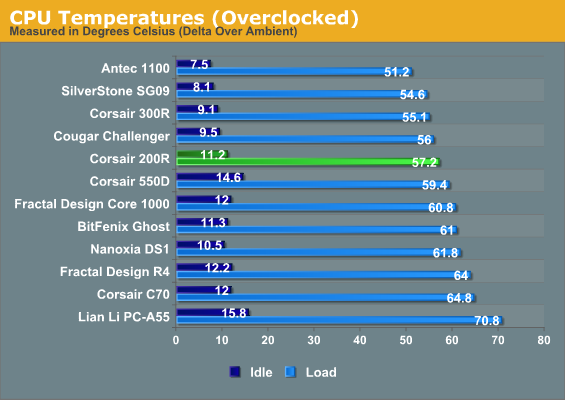
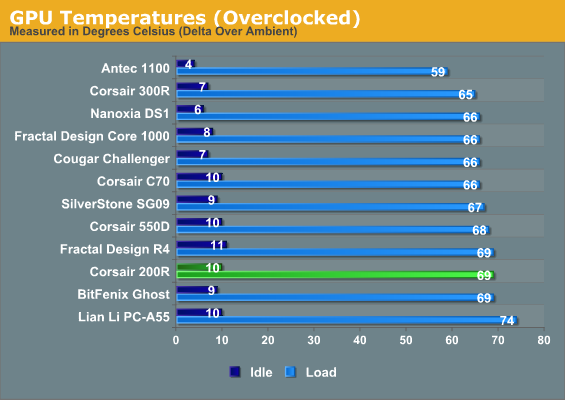

You're not liable to get much extra latitude out of your video card in the Carbide 200R, and SSD temperatures continue to be incredibly problematic, but you can definitely score some additional mileage out of your CPU. The Carbide 200R's CPU performance isn't stellar, but it's strong enough.
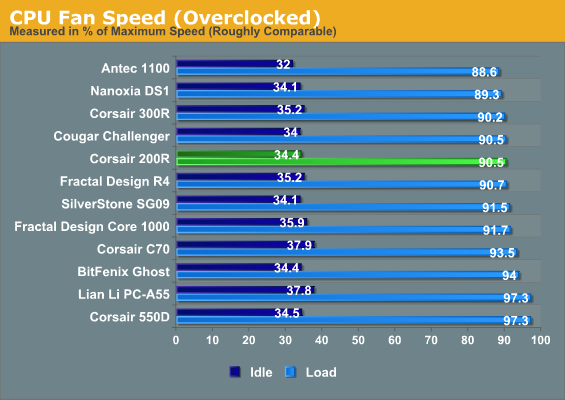
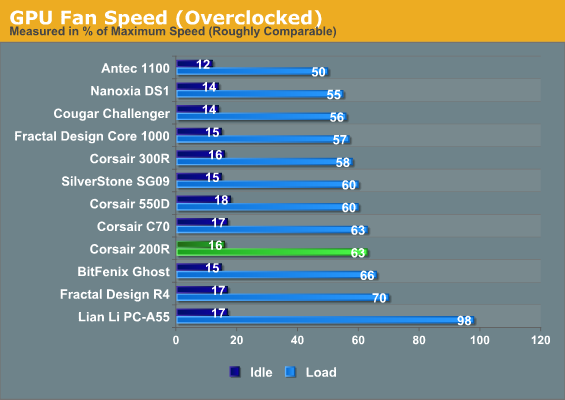
Fan speeds aren't ideal, but they're at least still on the lower end of competitive.
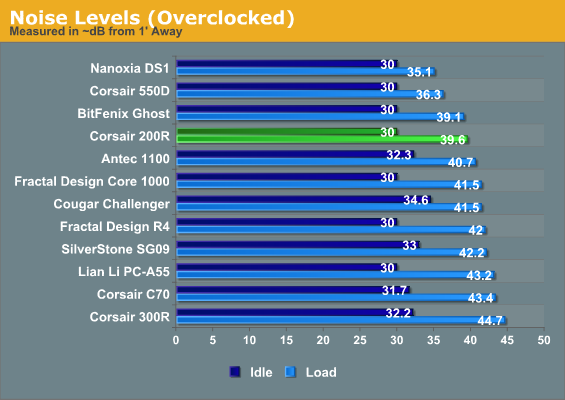
Noise levels also aren't particularly good, but they're not awful, either. Nobody's going to accuse the Carbide 200R of being a quiet enclosure. That's not what it's designed for, though, so we can let a little bit of noise slide.










25 Comments
View All Comments
Grok42 - Saturday, December 15, 2012 - link
I like to see good clean looking case designs like this at a low price point. Given the price I would expect some compromises and honestly it could have been a lot worse. I think the industry needs more experimentation with how internal drives are mounted so I applaud any effort even failures. Hopefully they will come back with something better next time around. Maybe next time they will save some money by killing the external bays and putting the resources into the internal bays.versesuvius - Saturday, December 15, 2012 - link
The only time one needs a tool for a case is the hard drive and other storage parts. The problem is not that people do not know how to use a screw driver, but that it has screws on the two sides of the case. As it is right now, you have to go through more trouble with the toolless case than you have with traditional ones. The answer lies not with the case manufacturers, but with internal storage manufacturers. It is very ease to design a hard disk casing so that it needs screws only on one side, and not two. Yet after maybe 30 years of hard disks, the casing has not changed a bit. Even the SSD casing design has adopted the same philosophy. As far as backward compatibility goes, the casing can be designed to accommodate old cases as well. Anyway, I agree with the article about the drive cage. It is a stupid decision in all cases to begin with and it is stupid here too. After all, how many drives one changes during the lifetime of a PC? Two? As long as the case has to be opened that amounts to 10 during the lifetime of a case, while the extra accumulated heat is there all the time.arthur449 - Saturday, December 15, 2012 - link
"How many drives one changes during the lifetime of a PC?"I have a Coolermaster ATCS-200 case I bought in 2000 still kicking around the house. While it only has 80mm fans, it remains a very attractive and functional case for 'that random frankenputer' one generally has after a few years of building their own PCs.
How many times have I changed the drives in that case? More times than I can remember. Some of them due to drive failures, some due to SSD / SAS experimentation, and many times for just cramming old drives in there and doing some bare metal testing of the latest silly OS that trickles down the MS TechNet vine.
A good case will survive multiple generations of hardware, and (since its target audience is already building their own computers) will more than likely put up with many drive swaps as it's handed down to friends, relatives, or simply demoted to closet server duty.
Lonyo - Saturday, December 15, 2012 - link
I still have my ACTS 200 or 201, and the next gen replacement case for it, but neither are in proper use.The motherboard tray from one is in use for a makeshift computer elsewhere where I can't use the full case.
The drive cages in both are hideous though, compared to modern cases. We have come a long way from the old days.
piroroadkill - Saturday, December 15, 2012 - link
I won't buy a case with an open top.Too much chance something will spill in it, or dust will settle on my gear.
Copy Lian-Li and Fractal Design - give us a simple option to use the holes or not.
Blibbax - Saturday, December 15, 2012 - link
That'd add cost. It could sold as an accessory though - I too avoid open top or even open side cases.Tech-Curious - Saturday, December 15, 2012 - link
Toss some sound dampening material over the fan mounts you don't intend to use; it works like a charm. The only problem, in my experience, is that the adhesive on sound dampening material is so strong that your decision is basically permanent.It's funny, I bought a box of sound dampening material, just for kicks, like seven years ago and I never used it as it was (presumably) intended to be used -- but I've used bits and pieces to great effect. And I still have some left.
Cut out four tiny little strips of the stuff and place it on the borders of your fan mounts, and vibration basically disappears. That silly-sounding trick single-handedly resurrected two positively ancient (circa 2002) jet-engine-sounding cases (6+ 80mm fan mounts each) that were sitting in my basement, collecting dust.
Tech-Curious - Saturday, December 15, 2012 - link
That said, I agree that the proliferation of computer cases featuring fan mounts in every available space is somewhat annoying -- especially given that those cases typically only come with 2 fans out of the box.Likewise, I'd love to see more cases with the old fashioned top-mounted PSU design. I understand the benefits of the alternative, but even with a filter, a bottom-mounted PSU is less than ideal on my carpeted floor.
Blibbax - Saturday, December 15, 2012 - link
Agreed on all accounts.TekDemon - Sunday, December 30, 2012 - link
I think it's actually great since it's the cheapest case that appears to support the H100 cooler, which was the main reason I bought my Carbide 400R (which I love-it's an awesome case). I wouldn't have been able to use this case though since I have a super long pci-e card.